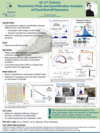PhD-Project Q1 by Dadiyorto Wendi (UP):
Regional flood hazard changes from a space-time recurrence perspective
Timescale: Oct. 2015 – April 2019
Supervisors:
Prof. Dr. Bruno Merz, Helmholtz Centre Potsdam GFZ German Research Centre For Geosciences
Dr. Norbert Marwan, Potsdam Institute for Climate Impact Research PIK
Background
Temporal changes in flood hazard are difficult to detect and attribute, since flood changes are caused by multiple drivers. These drivers, such as human-induced climate change, natural climate variability, implementation of flood defence, river training, or land use change, act on different space-time scales and may mask each other. Recurrence analysis is a modern and powerful method to investigate dynamics, transitions, and even indirect couplings. Further developments of this technique will allow studying data of extreme events, data with uncertainties, and spatio-temporal recurrences.
Objectives and Methods
The PhD-project aimed at better understanding and quantifying temporal changes in flood characteristics. Recurrence analysis, a novel and powerful method to investigate dynamics, transitions, and even indirect couplings, was applied to address the dynamics of flood events at two time scales: At the flood event time scale to understand the interactions of variables that lead to floods, and at the interannual to decadal time scale to understand the dominant controls on the long-term temporal changes in flood hazard. The project was based on a regional, data-driven approach by analysing the recurrence behaviour of several hundred catchments. The flood behaviour of single catchments may be strongly ‘contaminated’ by local effects, such as implementation of flood retention basins. Analysing the regional recurrence behaviour, i.e. the behaviour of many catchments for the same time period, promises to improve the signal-to-noise ratio and to better identify regional drivers of changes.
Transitions are related to a change in the recurrence behaviour of internal dynamics. Recurrence based analysis techniques were developed and applied to study such changes and to characterise typical transition pathways and potential precursors in the occurrence of floods. We analysed regional-scale changes in flood hazard by adopting recurrence analysis for past flood behaviour of several 100 catchments in Germany, Austria and Switzerland. Probabilistic and spatio-temporal extensions of recurrence analysis have been developed for the characterisation of dynamical transitions, to find potential precursors, and to evaluate uncertainties of the recurrence characteristics. The spatio-temporal extension of the recurrence approach will also assist other projects using spatio-temporal data, e.g., remote sensing or seismic, within NatRiskChange.
Main results
- Simple, easy to use, yet effective shuffling tool has been developed to test if the RP and RQA parameterization is safe from artifacts. Furthermore, the extension of RP and RQA with improved reliability have been developed in order to avoid further artifacts especially from noisy data.
- The main benefit of the developed approach is that we can detect similarity and synchronicity between hydrological time series, even when the similarity pattern is nonlinear and non-monotonic. Further, the approach can be used to quantify not only similarity of a continuous hydrograph shape, but also the implicit effect of the antecedent conditions towards the shape of a hydrograph.
- The similarity approach has been found to be useful to detect rare and unseasonal process dynamic implied by the shape of the hydrograph. This similarity quantification tool and index are proposed to be useful for simulation model evaluation and optimization as well, especially when non-stationarity is present.
Publications within NatRiskChange:
AGARWAL, A., BOESSENKOOL, B., FISCHER, M., Hahn, I., Köhn, L., LAUDAN, L., MORAN, T., OZTURK, U., Riemer, A., Rözer, V., SIEG, T., VOGEL, K., WENDI, D., Bronstert, A., Thieken, A.H. (2016): Die Sturzflut in Braunsbach, Mai 2016 - Eine Bestandsaufnahme und Ereignisbeschreibung. Taskforce im Rahmen des DFG-Graduiertenkollegs Natural Hazards and Risks in a Changing World, Universität Potsdam (Publisher), 20 pages, urn:nbn:de:kobv:517-opus4-394881.
Bronstert, A., AGARWAL, A., BOESSENKOOL B., Crisologo I., FISCHER M., Heistermann M., Köhn-Reich L., MORAN T., OZTURK U., Reinhardt-Imjela C., WENDI D. (2018): Forensic hydro-meteorological analysis of an extreme flash flood: The 29/05/2016 event in Braunsbach, SW Germany, Science of the Total Environment, 630: 977-991. https://doi.org/10.1016/j.scitotenv.2018.02.241.
Bronstert, A.,AGARWAL, A., BOESSENKOOL, B., FISCHER, M., Heistermann, M., Köhn-Reich, L., MORAN T., WENDI, D. (2017): Die Sturzflut von Braunsbach am 29. Mai 2016 – Entstehung, Ablauf und Schäden eines „Jahrhundertereignisses“. Teil 1: Meteorologische und hydrologische Analyse, Hydrologie & Wasserbewirtschaftung, 61(3): 150-162; https://doi.org/10.5675/HyWa_2017,3_1.
Bronstert, A., Crisologo, I., Heistermann, M., OZTURK, U., VOGEL, K., WENDI, D. (2019): Flash-Floods: More often, More severe, More damaging? An Analysis of Hydro-Geo-Environmental Conditions and Anthropogenic Impacts, accepted for publication in: Springer Book Series "Climate Change Management”, Symposium on "Climate Change and Natural Hazards", University of Padova, Italy, 25-26/02/2019.
OZTURK U., WENDI D., Crisologo I., Riemer A., AGARWAL A., VOGEL K., López-Tarazón A. J., Korup O. (2018c): Rare flash floods and debris flows in southern Germany, Science of the Total Environment, 626: 941-952, https://doi.org/10.1016/j.scitotenv.2018.01.172.
WENDI, D., Merz, B., & Marwan, N. (2019). Assessing hydrograph similarity and rare runoff dynamics by cross recurrence plots. Water Resources Research, 55, 4704– 4726. doi.org/10.1029/2018WR024111.
WENDI, D., Marwan, N. (2018): Extended recurrence plot and quantification for noisy continuous dynamical systems, Chaos, 28: 085722, https://doi.org/10.1063/1.5025485.
WENDI, D., Marwan, N., Merz, B.(2018): In Search of Determinism-Sensitive Region to Avoid Artefacts in Recurrence Plots, International Journal of Bifurcation and Chaos, 28(1): 1850007, https://doi.org/10.1142/S0218127418500074.
VOGEL, K., OZTURK, U., Riemer, A., LAUDAN, J., SIEG, T., WENDI, D., AGARWAL, A., Rözer, V., Korup, O., Thieken, A.H. (2017a): Die Sturzflut von Braunsbach am 29. Mai 2016 - Entstehung, Ablauf und Schäden eines “Jahrhundertereignisses”. Teil 2: Geomorphologische Prozesse und Schadensanalyse, Hydrologie & Wasserbewirtschaftung, 61(3): 163-175, https://doi.org/10.5675/HyWa_2017,3_2.
Thesis to download:
Recurrence Plots and Quantification Analysis of Flood Runoff Dynamics

